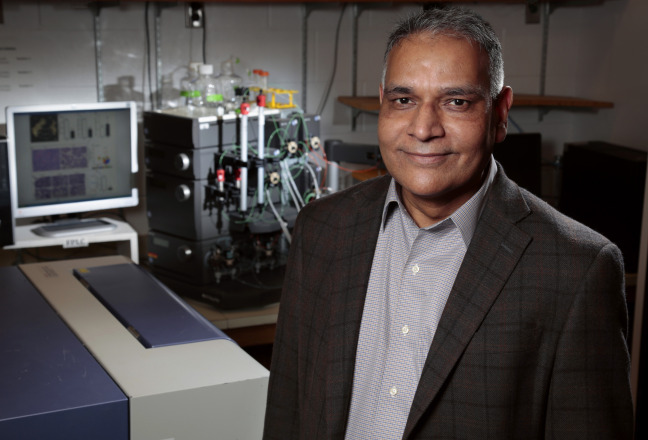
Ravindra Singh, professor of biomedical sciences, led a research team that created a shortened version of the gene that cause spinal muscular atrophy. The super minigene will make it easier to find potential treatments for the often-fatal disease, which affects about 1 in 10,000 newborns. Photo by Christopher Gannon/Iowa State University. Larger image.
AMES, Iowa – Ravindra Singh has spent years studying a gene that when missing or mutated causes spinal muscular atrophy (SMA), a deadly disease that’s among the most common genetic disorders in children. His team’s latest work will make the search for treatments even more effective in the years to come.
Singh, a professor of biomedical science at Iowa State University, led an eight-year project to create a truncated version of the Survival Motor Neuron 2 (SMN2) gene to facilitate quicker, cheaper and less fragmented research. Nucleic Acids Research, a peer-reviewed academic journal, recently published the team’s article describing its work.
Researchers have for decades isolated segments of genes to study them, creating what is often called a minigene. But the condensed version of SMN2 developed by Singh and his colleagues represents the entire gene. Despite being 5 to 10 times shorter than natural SMN2 genes, which include roughly 28,000 base pairs, the model Singh’s group built allows scientists to see how changes play out across the gene expression process – from transcription to translation to protein production. They call it a “super minigene.”
“Now we can make mutations anywhere and quickly see what happens everywhere in the sequence,” Singh said.
Molecular biologists often specialize in particular aspects of genetic expression. For instance, Singh said, he has focused on splicing, which removes non-coding sequences called introns as messenger RNA forms. Having a simplified testing ground that covers the whole gene will push research to be more holistic, avoiding a potential silo effect and better capturing interactions.
“Transcription, splicing, translation, protein production – they’re all connected. Transcription affects splicing, but splicing also affects transcription. It’s a two-way street,” Singh said. “But there hasn’t been an efficient way to study the entire system. The super minigene provides a tool to test all mechanisms at the same time. Instead of five experiments, you do one experiment, and it makes for more accurate results.”
The super minigene’s compactness comes largely from eliminating introns, though not all of them. Some noncoding segments are retained to ensure similar stability and accuracy, Singh said. It was a time-intensive project because there was no prior work to use as a pattern. Researchers individually looked at 30 different processes as they stitched the model together.
“Each of those steps had to be separately optimized before we combined them, and if they didn’t fit, we went back to the drawing board,” he said. “It’s like building a house with components that weren’t designed to go together.”
In about 90% of cases the researchers tested, the super minigene expressed the same results as the whole SMN2 gene, Singh said.
“We would have been happy with 50%. That was a big achievement,” he said.
Singh has a history of discovering potential treatments for SMA, including a target that led to the first federally approved treatment for the disease. He said the super minigene will make it easier to find possible therapies for SMA, which is diagnosed in 1 of every 10,000 births. In its most common and severe form, SMA causes muscle weakness and inhibits motor control development in infants. Children suffering from the severe form of SMA, also known as Werdnig-Hoffman disease, have an average lifespan of two years.
The breakthrough also is likely to have impact that extends beyond SMA, Singh said.
“This amounts to a proof of the system, so I fully expect other research teams to copy this process. Someone will make this for other genes, such as those related to ALS or Parkinson’s. It’s just a matter of time,” he said.